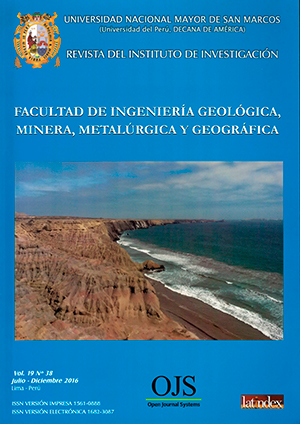Disergonomics risk by phisical loading in the work of underground mining and improving the safety and health of workers
DOI:
https://doi.org/10.15381/iigeo.v19i38.13571Keywords:
Disergonomics risk, underground mining work, ergonomic evaluation methods, musculoskeletal diseasesAbstract
his study proposes an approach to knowledge of disergonomic risk factors for physical load (unfavorable postures, muscle groups efforts and energy expenditure) that are present in the underground mining work and affecting working conditions to the detriment of safety and health of workers. The objective analysis was described by the REBA Method, Job Strain Index and heart rate, simultaneously applied . For this purpose six representative tasks of the basic cycle of underground mining (blasting, unleashed rock drilling, rock support with wooden frames, cleaning with pneumatic shovel and haul ore), using twelve representative samples for each job were located. Thus was established which are the most unfavorable positions for working using the three methods mentioned above, was also established what muscle groups are most affected and the relation with medical reports of muscle skeletal ailments related to the job inside the mine using the contrast test Pearson x2. For determination of energy expenditure, it has been used the method of heart rate and degree Frimat penalty criterion work. It is quantitatively converting the heart rate in metabolic rate using mathematical equations and we want to determine cardiac output relative, absolute cardiac cost, cardiac acceleration, time of metabolic consumption, the level of food required and schedule the times required for the rest. The subjective analysis was performed using surveys of workers involved in underground mining tasks and involved issues concerning the discomfort location, pain level and frequency in different muscle groups. In that sense, this paper makes a comparison with the objective analysis with ergonomic tools. By the results of this research, the main goal is to obtain content about eminently practical information to which the entity is in a position to make appropriate decisions about the timing and type of preventive actions to be taken for those risks that have obtained the significant qualification. The magnitude of risk indicates the need for prioritize solution actions, and integrating it into a health and safety system.Downloads
Published
Issue
Section
License
Copyright (c) 2016 Max A. Hermoza L.

This work is licensed under a Creative Commons Attribution-NonCommercial-ShareAlike 4.0 International License.
AUTHORS RETAIN THEIR RIGHTS:
a. Authors retain their trade mark rights and patent, and also on any process or procedure described in the article.
b. Authors retain their right to share, copy, distribute, perform and publicly communicate their article (eg, to place their article in an institutional repository or publish it in a book), with an acknowledgment of its initial publication in the Rev. Inst. investig. Fac. minas metal cienc. geogr.
c. Authors retain theirs right to make a subsequent publication of their work, to use the article or any part thereof (eg a compilation of his papers, lecture notes, thesis, or a book), always indicating the source of publication (the originator of the work, journal, volume, number and date).






